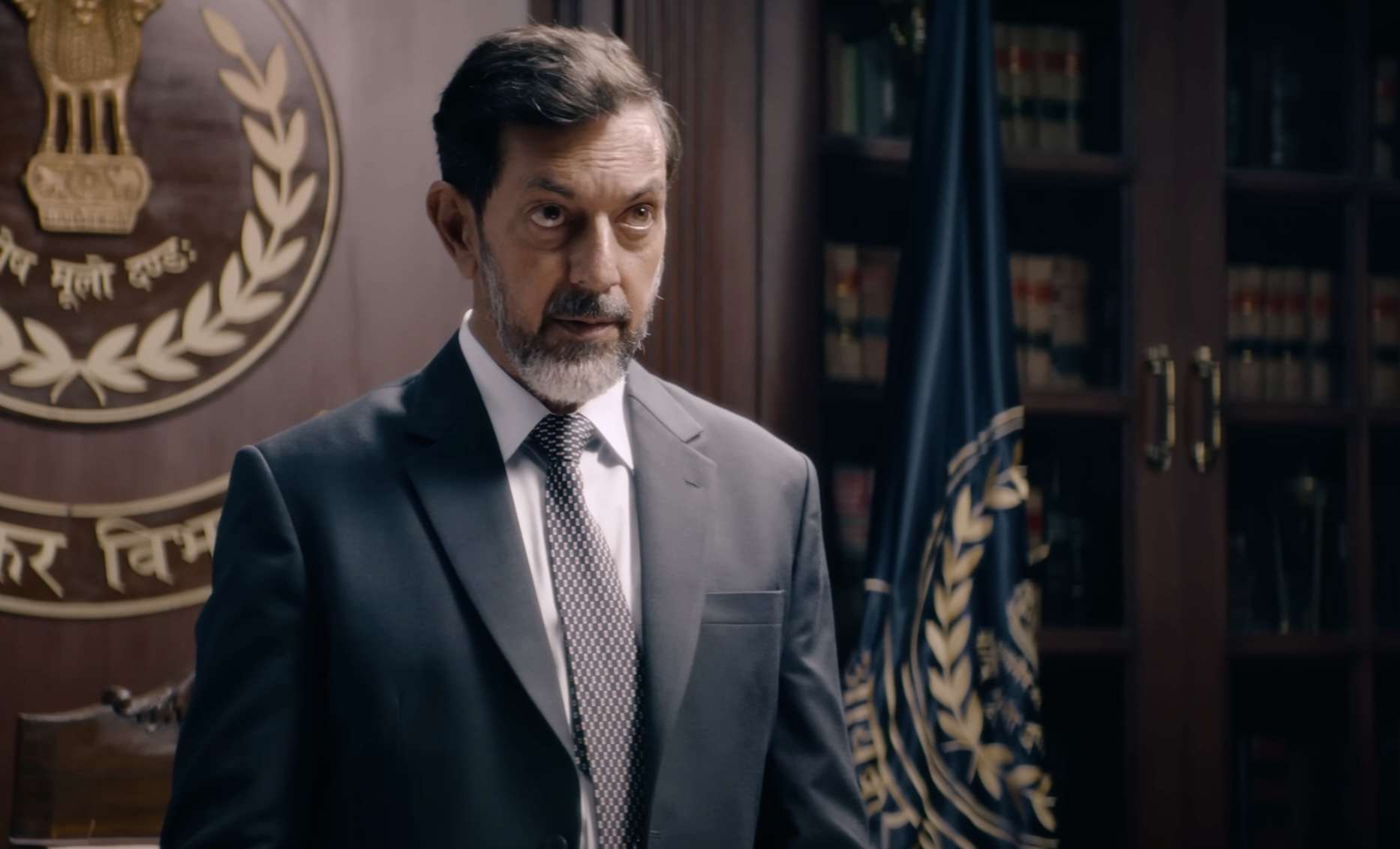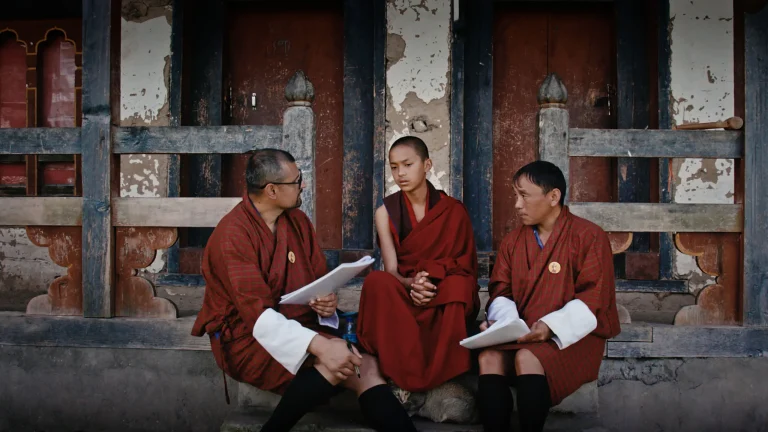With his identical aviators, sandals, and formal shirts tucked into plain trousers, Amay Patnaik (Ajay Devgn) returns to the big screen. To make his 75th raid successful, Patnaik, himself, devises his 74th transfer to Bhoj (a fictional state) and sets up a trap to catch Dada Manohar Bhai, aka Dada Bhai (Ritesh Deshmukh) – a messiah of the impoverished who, along with being a cabinet minister, also runs a foundation.
Following the prequel (“Raid,” 2018), “Raid 2” begins with the familiar shot of an income tax convoy moving towards its target, while the target’s vigilant informers run simultaneously with the convoy to alert their boss about the imminent raid. Although this raid at a powerful politician’s (Govind Namdev) palace does not succeed, this instant failure leads our protagonist to map and spot his ultimate target.
Bhoj, before Patnaik’s arrival, appears to be a peaceful state where everything used to be in order. It is Patnaik who discovers the undercurrent of a consistent forgery running through the veins and arteries of the state. Every clue that Patnaik detects – who, rather than an Income Tax Officer, has been portrayed as an omnipotent sleuth in the film – alludes to him orchestrating his 75th raid at Dada Bhai’s mansion.

Since Dada Bhai is a far more powerful and influential rival than the last time, the raid is expected to be much more intense and thrilling, but, in reality, it isn’t. While the prequel’s USP lay in the key moments of the raid, where the antagonist – “Tauji” (Saurabh Shukla) – had to struggle to create his own space (often using silence as a method) to convey his fierceness through the eyes, “Raid 2” is keener to explore the rivalry between two heavyweights in spicy face-offs (cooked with dialogues that do not gather claps at all) and fails to achieve its objective. A flawed writing is chiefly responsible for this failure, which needs to be discussed here.
The franchise, which is likely to grow in many films in the near future, tried and tested its unique formula in the very first installment. The simple attire, amid the outlandish glamour milieu of Bollywood, of Amay Patnaik and his incisive honesty was received well by the masses. Apart from this inner aesthetics, there is yet another important aspect that the first segment of the franchise explored. While the bulk of mainstream Bollywood, in the recent past has mostly engaged with inter-nation issues (border disputes, heroics of Indian army etc.) and period-dramas (primarily rechurning and propagating a monolithic religion and culture from the pages of history) in the sphere of nationalist cinema, Raid franchise has tried to shift the popular discourse from ‘inter’ to ‘intra’-national issues.
The franchise delineates Amay Patnaik as an ideal figure who is committed to revamping the Income Tax department and rectify all the odds running through the underbelly of India. But, since cinema is not merely a message on the wall, this act of rectification alone cannot be regarded as the yardstick of a film’s artistic excellence.
Since “Raid” had already created a stage for its sequel, “Raid 2” didn’t have to carry the pressure of experimenting, yet it fails to prove itself a worthy successor to the prequel. The writer’s lack of grip on the characters is conspicuous. In “Raid 2,” the simplicity of Amay Patnaik loses its organic charm. It seems the simplicity has been imposed upon Amay because his occasional brainstorming sessions, with a Sherlock-like cigarette in hand, are in constant duel with his previous image.

Amay of “Raid 2” at times tries to break free from his earlier modestly dressed, honest self. On the other hand, Dada Bhai’s character has been portrayed with such heavy layers that, till the end of the film, we could not find a glimpse of his typical villainous primordial fury, which limits his fierceness to being rhetorical rather than practical. It happens when a writer piles layers upon layers onto a character, but neither offers the audience the required space to understand its bildung nor provides the character with the necessary space and time to shake off the layers when needed. Apart from them, the other characters had nothing much to offer except Lallan’s (Amit Sial) infrequent comic relief in the second half.
The storyline also lacks all the spices the prequel had offered. Songs are used mostly to veil the lapses in the story, so they seem to emerge from an odd time and space. The dance number, starring Tamannah Bhatia, appears all of a sudden and ends without adding the extra force in the narrative speed that one often expects from such songs. Bollywood, for long, tends to place dance numbers (earlier called cabaret numbers) typically in the middle of a film, and these numbers have always been used as a conjoint between two different forces of a particular narrative. So, when a dance number fails to serve this purpose, it suggests the sheer incompetence of such typcast traditions.
“Raid 2” not only disappoints us with its poor writing and execution (full of mainstream age-old Bollywood tropes) but it also derails from the standardized position that Raj Kumar Gupta (director of the film) himself created seven years ago with the prequel. While a section of the audience demands Bollywood to grow in quality, “Raid 2” harshly reminds us that the industry is interested not in reshaping the prevalent aesthetics, but in enhancing its existing money-making tropes with more modish ingredients. In short, the Raid franchise, before its completion, has fallen prey to the box-office-driven shabby formulas.



![A Fugitive from the Past [1965] Review – Probing the Postwar Devastation of Japan through Thriller Framework](https://79468c92.delivery.rocketcdn.me/wp-content/uploads/2020/07/A-Fugitive-from-the-Past-1965-768x495.jpg)


![And Then We Danced [2019] Cannes Review – A Georgian combination of Call Me By Your Name & Whiplash](https://79468c92.delivery.rocketcdn.me/wp-content/uploads/2019/05/and-then-we-danced-high-on-films-768x432.jpg)

I agree 100 % with this review , dissappointed with Raid 2 .
The characters have neither space nor back story for growth . The biggest dissapoinenters were the writers directors and composers .